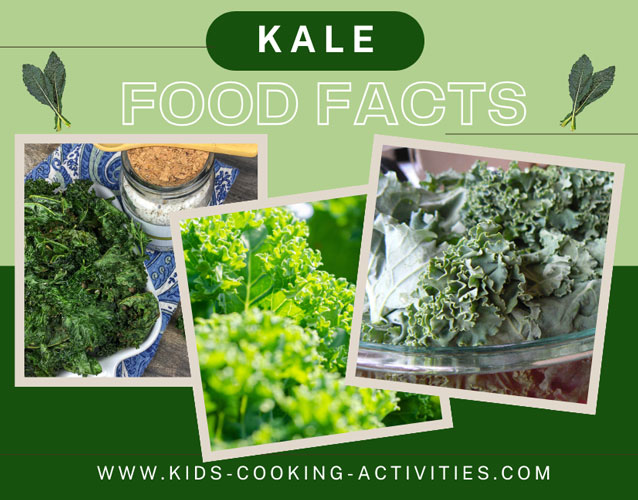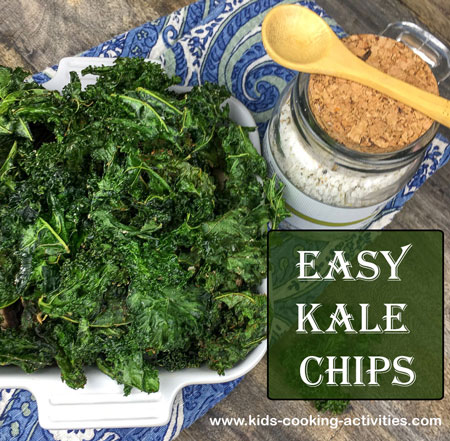- Home
- Food Facts
- Kale
Kale Facts

Kale facts and general information about Kale.
Kids Cooking Activities Teaching Materials
Make teaching easier with our activities and recipes compiled in theme sets and books with an easy to read formatPerfect for teaching!

~This post may contain affiliate links and I'll earn a small commission if you shop through them. There is no extra cost to you. This is how we help support our family and continue to bring you amazing content. To learn more see the affiliates disclosure here.~
Kale is Available:
Plant early spring through summer for your kale to be ready by late summer. Some types of kale can be grown in cooler weather and can be planted in the fall for a autumn harvest.How Does Kale Grow:
Kale grows tall, curvy leaves. It is a 2 year plant, it will grow for 2 years.What to Look for When Buying:
Look for kale that is not wilted but with crisp leaves and bright green in color.Storage Tips:
Store in a bag in the refrigerator in a vegetable drawer if available. You can freeze kale leaves. Once frozen the leaves can be easily broken in pieces and added to soups or dishes.How to Cook:
To boil kale, rinse a bunch of kale thoroughly with cold water and then remove the spine by cutting off the thick inner stem. Boil a big pot of water, adding about 1/2 teaspoon of salt. While the water is boiling, place kale in the water and stir. Then cover the pot in a way that leaves a little room for steam to escape. Quickly cooking kale in this manner means you won't lose any of its structure or color.After four minutes, stir the kale and then recover, cooking for another three minutes before testing a piece of kale for doneness. If it is a little chewy but not tough, then it is done. Strain and rinse kale immediately with cold water in order to prevent it from becoming too soft.
Putting salt in kale water not only enhances taste but also shortens the time it takes to cook kale. Without salt, the toughness of the plant apparently increases cooking time as much as 10 to 15 minutes. In addition, salt keeps the water from becoming too acid, which prevents kale from turning a washed-out, somewhat unappetizing green color. I forgot to add salt one time and it does indeed turn kale a grayish-green color that doesn't make people want to eat it.
Saute kale in a pan with some crushed garlic and one tablespoon of olive oil over medium heat and add it to salads or meat dishes. When learning how to cook kale recipes, I noticed that many recipes often incorporate lemon juice or balsamic vinegar.
After doing a little research, I discovered that this is to heighten the flavor of kale and to also draw out the rich amounts of vitamins and minerals in the vegetable. So don't forget to add one of these two ingredients when making kale recipes.
Nutrition Facts:
Kale is high in Vitamin K like other greens like parsley, collard greens or spinach. It is high in calcium and omega 3 fatty acids. (super food!)Kale Recipes:
Making Kale Chips
 Ingredients:
Ingredients:- 1 1/2 bowl of fresh kale leaves
- 1 Tablespoon olive oil
- Sea salt, to taste *
Preheat the oven to 450 degrees Fahrenheit and prepare a baking sheet by greasing it lightly with oil.
Cut out the kale leaves from the bunch and rinse under running water. Dry the rinsed kale leaves with paper towels. Dump the kale leaves in a bowl and sprinkle olive oil over the leaves.
Sprinkle sea salt over the kale leaves and toss the leaves to coat. Spread the kale leaves over the baking tray. Insert the baking tray in the preheated oven and bake for 15-20 minutes or until the leaves turn crispy and slightly blackish in color.
*Experiment with different spices such as adding paprika, garlic or cumin.
Share your food facts and recipes
Do you have a food facts or recipe to share?
Reader's Submitted Recipes
Click below to see contributions from other visitors to this page...
How to cook kale Not rated yet
I had to practice a few times before I learned how to cook kale. Sometimes you don't even need to cook kale, especially when it is mixed with salads and …
Related Food Facts Pages:
~Apple, ~Apricot, ~Avocado, ~Banana, ~Berry, ~Cherry, ~Coconut, ~Cranberry, ~Dates, ~Figs, ~Grapefruit, ~Grapes, ~Kiwi, ~Lemon and Limes, ~Mango, ~Melon, ~Orange, ~Papaya, ~Peach, ~Pear, ~Pineapple, ~Plums, ~Tomato, ~Artichoke, ~Asparagus, ~Beets, ~Broccoli, ~ Brussels Sprouts, ~Cabbage, ~Carrot, ~Cauliflower, ~Celery, ~Corn, ~Cucumber, ~Eggplant, ~Garlic, ~Green Beans, ~Kale, ~Lettuce/Salad Greens, ~Mushrooms, ~Okra, ~Onion, ~Parsnip, ~Peas,green, ~Peppers, ~Potato, ~Radish, ~Rhubarb, ~Spinach, ~Summer Squash and Zucchini, ~Sweet Potato, ~ Turnip, ~ Winter Squash, including Pumpkins, ~Beans, ~Eggs, ~Nuts, ~Seeds, ~ Meat, ~ Dairy, ~ Grains
Follow Kids Cooking Activities






